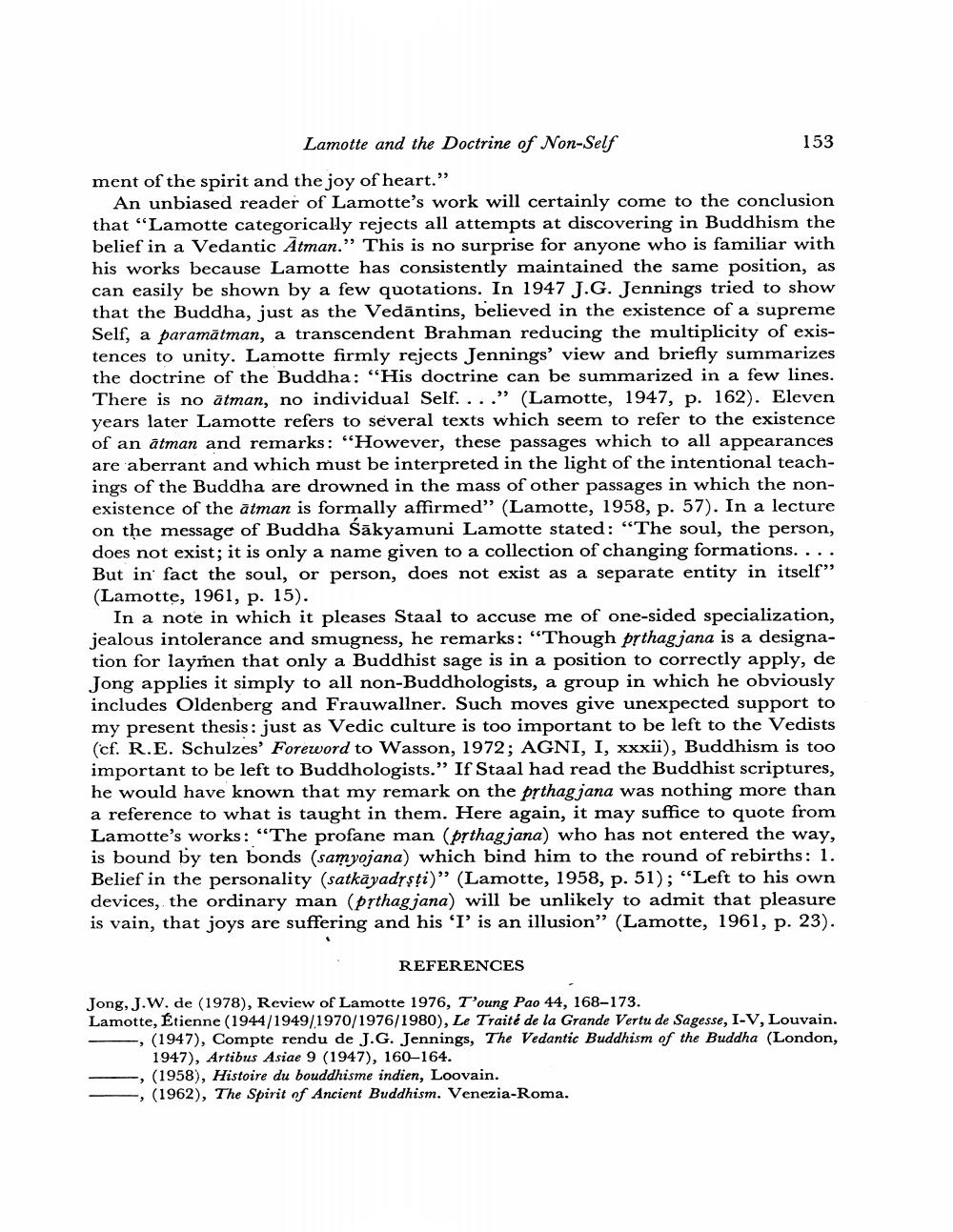Book Title: Lamotte And Doctrine Of Non Self Author(s): J W De Jong Publisher: J W De Jong View full book textPage 3
________________ Lamotte and the Doctrine of Non-Self 153 ment of the spirit and the joy of heart." An unbiased reader of Lamotte's work will certainly come to the conclusion that "Lamotte categorically rejects all attempts at discovering in Buddhism the belief in a Vedantic Atman." This is no surprise for anyone who is familiar with his works because Lamotte has consistently maintained the same position, as can easily be shown by a few quotations. In 1947 J.G. Jennings tried to show that the Buddha, just as the Vedantins, believed in the existence of a supreme Self, a paramatman, a transcendent Brahman reducing the multiplicity of existences to unity. Lamotte firmly rejects Jennings' view and briefly summarizes the doctrine of the Buddha: "His doctrine can be summarized in a few lines. There is no atman, no individual Self. ..." (Lamotte, 1947, p. 162). Eleven years later Lamotte refers to several texts which seem to refer to the existence of an atman and remarks: "However, these passages which to all appearances are aberrant and which must be interpreted in the light of the intentional teachings of the Buddha are drowned in the mass of other passages in which the nonexistence of the atman is formally affirmed" (Lamotte, 1958, p. 57). In a lecture on the message of Buddha Sakyamuni Lamotte stated: "The soul, the person, does not exist; it is only a name given to a collection of changing formations.... But in fact the soul, or person, does not exist as a separate entity in itself" (Lamotte, 1961, p. 15). In a note in which it pleases Staal to accuse me of one-sided specialization, jealous intolerance and smugness, he remarks: "Though psthagjana is a designation for laymen that only a Buddhist sage is in a position to correctly apply, de Jong applies it simply to all non-Buddhologists, a group in which he obviously includes Oldenberg and Frauwallner. Such moves give unexpected support to my present thesis: just as Vedic culture is too important to be left to the Vedists (cf. R.E. Schulzes' Foreword to Wasson, 1972; AGNI, I, xxxii), Buddhism is too important to be left to Buddhologists." If Staal had read the Buddhist scriptures, he would have known that my remark on the psthag jana was nothing more than a reference to what is taught in them. Here again, it may suffice to quote from Lamotte's works: "The profane man (pethagjana) who has not entered the way, is bound by ten bonds (samyojana) which bind him to the round of rebirths: 1. Belief in the personality (satkayadrsti)" (Lamotte, 1958, p. 51); "Left to his own devices, the ordinary man (p?thagjana) will be unlikely to admit that pleasure is vain, that joys are suffering and his 'I' is an illusion" (Lamotte, 1961, p. 23). REFERENCES Jong, J.W. de (1978), Review of Lamotte 1976, T'oung Pao 44, 168-173. Lamotte, Etienne (1944/1949/1970/1976/1980), Le Traite de la Grande Vertu de Sagesse, I-V, Louvain. - (1947), Compte rendu de J.G. Jennings, The Vedantic Buddhism of the Buddha (London, 1947), Artibus Asiae 9 (1947), 160-164. - (1958), Histoire du bouddhisme indien, Loovain. , (1962), The Spirit of Ancient Buddhism. Venezia-Roma.Page Navigation
1 2 3
